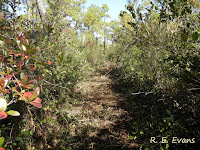 |
| Longleaf pine stand and prescribed burn near the coast of North Carolina; flame lengths and intensity are greater than many managers would prefer |
 |
| Longleaf "flattop"; these trees often represent remnants of earlier forests skipped over by loggers |

Mechanically reducing the fuels in such stands can help protect high-value individual trees and lower overall fire intensity. However, doing so across large and heavily overgrown stands takes a concerted approach. Several years ago, we stepped up and took one (a concerted approach, that is).
 |
| The "concerted approach"! Skid steer equipped with forestry cutter |
We acquired a skid steer equipped with tracks to minimize ground disturbance, a special cab to protect the operator, and a "forestry cutter". Examples of how we used it are shown below:
 |
| Disappearing mower and mowed swath through heavy "bay" fuels Brunswick Co, NC |
 |
| Mower headed straight toward remnant longleaf pine, barely evident from a distance due to tall shrub and Pond Pine (Pinus serotina) encroachment |
In these circumstances it was the perfect way to go "looking for longleaf".
The images below show this stand before and after treatment. Note the lone Longleaf pine with the Y-shaped canopy near the center. Amazingly, a young longleaf pine was hiding in the dense brush immediately in front of this tree (click & enlarge image right). After clearing, the stand displayed the open structure typically associated with longleaf pine savannas and woodlands - a restoration success?. Comment appreciated!
 |
| Longleaf pine stand with relicts, after mulching treatment (same stand as above) Note - turpentine faces on 2 of the trees. Brunswick Co, N.C. |














